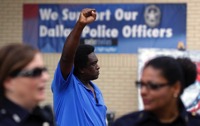
The public backlash against police shootings of black people is helping fuel the growth of black hate groups, some of which advocate retaliatory violence against law enforcement, watchdog groups said Monday.
The Southern Poverty Law Center counted 113 groups advocating black separatism, black supremacy or some other extreme, black-centric ideology in the United States in 2014. By the end of 2015, in the aftermath of last year’s killing of a black man by a white police officer in Ferguson, Missouri, the number had grown to 180, an increase of nearly 60 percent in less than a year…
No one knows exactly how many people have been drawn to black extremist groups, but there’s no reason to believe the growth of violent ideology is slowing. Last week’s protests of police shootings in Louisiana and Minnesota have only spread since a black sniper killed five police officers at a demonstration in Dallas.
“It draws people to their ranks, people who are mad about what is going on with law enforcement,” said Heidi Beirich, director of the Alabama-based center’s Intelligence Project, which tracks extremist organizations.
People who join such organizations might not pose the biggest threat anyway, said Oren Segal of the Anti-Defamation League. He agrees that killings by police and the ensuing protests provide fuel for black extremist groups, but believes exact numbers are hard to pin down.
“The most dangerous are those who don’t join anything, who get inspired by the militancy or hate, who get influenced by the rhetoric, and act on their own,” said Segal, who directs the ADL’s Center on Extremism.
Dallas gunman Micah Xavier Johnson apparently fell into this category: The 25-year-old Army veteran wasn’t known to be an active member of any group, but he was on Facebook, and followed the feeds of the New Black Panther Party and the Black Riders Liberation Party.
He also “liked” the African-American Defense League, which formed in 2014 and advocates violence against police and white people in general. The group has gathered more than 870 “likes” on its Facebook page, whose cover photo still showed dozens of military-style weapons days after Johnson killed five white officers.
Beirich said the Intelligence Project tracks hate groups through methods including its own research, reports by media and law enforcement, the groups’ own publications, and social media. Some radical black religious organizations also have houses of worship or book stores that can be counted, she said.
But determining a group’s true size and reach can be difficult, said the ADL’s Segal.
For example, he said, the New Black Panther Party is considered a “hard-core hate group” and members have advocated violence against police, yet it typically stages few events where watchdogs can count members, as they do with the KKK or the National Alliance, which are considered white hate groups.
Instead, he said, black extremists often join in demonstrations, and sometimes incite others in the crowd.
Adding to the difficulty is the fact that some black extremist groups use their advocacy of common social issues like eradicating poverty or improving education as a doorway to lead people down a path of militancy, he said.
“They take legitimate social issues that people care about and infuse them with their brand of hatred,” said Segal.